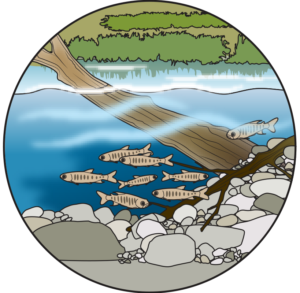
Install Large Wood
Coast Coho require a complex suite of habitat types while residing in freshwater. Many of these rely on the presence of large wood in the channel and floodplain. Large wood increases the connectivity of stream channels with their floodplain terraces and promotes slow moving side channels and alcoves that allow juveniles to escape high winter flows. Deep, cool pools created by large wood provide juveniles with refuge from high summer water temperatures and support macro-invertebrate communities (food). Coarse sediments captured above and below installed wood provide spawning gravel, which is essential in systems that are deficient in large wood and, consequently, are often dominated by bedrock substrates.
Land use on the coast has a long history of reducing the complexity of coho streams by removing beaver dams and other large wood structures. The targeted installation of large wood in streams benefits both the juvenile and adult life-stages of Coho salmon by enhancing watershed function and generating high quality habitats. In particular, the strategic placement of large wood (often including root wads) encourages water to pool, increases side channel flow, decreases water velocity, and provides cover from predators. A study conducted in western Oregon and Washington indicated that wintertime juvenile Coho densities were 3.2 times higher in streams treated with large wood compared to streams without the addition of wood (Roni and Quinn 2001).
